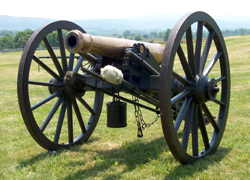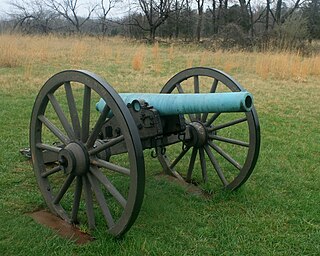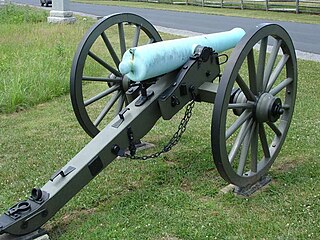
The Parrott rifle was a type of muzzle-loading rifled artillery weapon used extensively in the American Civil War.

The Ordnance BL 60-pounder was a British 5 inch (127 mm) heavy field gun designed in 1903–05 to provide a new capability that had been partially met by the interim QF 4.7 inch Gun. It was designed for both horse draft and mechanical traction and served throughout the First World War in the main theatres. It remained in service with British and Commonwealth forces in the inter-war period and in frontline service with British and South African batteries until 1942 being superseded by the BL 4.5 inch Medium Gun.
A limber is a two-wheeled cart designed to support the trail of an artillery piece, or the stock of a field carriage such as a caisson or traveling forge, allowing it to be towed. The trail is the hinder end of the stock of a gun-carriage, which rests or slides on the ground when the carriage is unlimbered.

Field artillery in the American Civil War refers to the artillery weapons, equipment, and practices used by the Artillery branch to support the infantry and cavalry forces in the field. It does not include siege artillery, use of artillery in fixed fortifications, or coastal or naval artillery. Nor does it include smaller, specialized artillery classified as small arms.

Siege artillery is heavy artillery primarily used in military attacks on fortified positions. At the time of the American Civil War, the U.S. Army classified its artillery into three types, depending on the gun's weight and intended use. Field artillery were light pieces that often traveled with the armies. Siege and garrison artillery were heavy pieces that could be used either in attacking or defending fortified places. Seacoast artillery were the heaviest pieces and were intended to be used in permanent fortifications along the seaboard. They were primarily designed to fire on attacking warships. The distinctions are somewhat arbitrary, as field, siege and garrison, and seacoast artillery were all used in various attacks and defenses of fortifications. This article will focus on the use of heavy artillery in the attack of fortified places during the American Civil War.

The Armstrong Breech Loading 12 pounder 8 cwt, later known as RBL 12 pounder 8 cwt, was an early modern 3-inch rifled breech-loading field gun of 1859.

The Canon de 12 Gribeauval or 12-pounder was a French cannon and part of the system developed by Jean Baptiste Vaquette de Gribeauval. There were 1.079 English pounds in the Old French pound, making the weight of shot nearly 13 English pounds. The 12-pounder was the heaviest cannon in the French field artillery; the others were the light Canon de 4 Gribeauval and the medium Canon de 8 Gribeauval. Superseding the previous Vallière system, the Gribeauval system was adopted in 1765 and its guns were first used during the American Revolutionary War. The greatest use of Gribeauval guns came during the French Revolutionary Wars and the Napoleonic Wars. During the latter wars, the 12-pounder was often employed in corps artillery reserves. Because of their physical and psychological effect, Emperor Napoleon increased the number of 12-pounders in his artillery and fondly called the cannons his belles filles. Gribeauval cannons fired canister shot for close-range work and round shot at more distant targets. In 1803 the Year XI system was introduced, but it only partly replaced the Gribeauval system which was not completely replaced until the Valée system was set up in 1829.
The Pointe Coupee Artillery was a Confederate Louisiana artillery unit in the American Civil War made up primarily of men from the parishes of Pointe Coupee, East Baton Rouge, Livingston and other surrounding parishes as well as a large number of men from New Orleans.
The Monticello Artillery (1862–1865) was a Confederate Army artillery battery during the American Civil War. The unit was also known as: Owen's Battery, or Howell's Battery. Some post war records refer to the unit as the Drew Light Artillery because most original members were from Drew County, Arkansas.

The 3-inch ordnance rifle, model 1861 was a wrought iron muzzleloading rifled cannon that was adopted by the United States Army in 1861 and widely used in field artillery units during the American Civil War. It fired a 9.5 lb (4.3 kg) projectile to a distance of 1,830 yd (1,670 m) at an elevation of 5°. The 3-inch rifle was not as effective in firing canister shot as the heavier 12-pounder Napoleon, but it proved to be highly accurate at longer ranges when firing common shell or spherical case shot. There was only one reported case of a 3-inch ordnance rifle bursting in action. This was in stark contrast to the similarly-sized cast iron 10-pounder Parrott rifles which occasionally burst without warning, inflicting injury on the gun crews. The Confederate States of America lacked the technology to manufacture reliable copies of the 3-inch ordnance rifle. However, the Confederate States Army respected the weapons and employed those captured from Federal forces.

The M1841 6-pounder field gun was a bronze smoothbore muzzle-loading cannon that was adopted by the United States Army in 1841 and used from the Mexican–American War to the American Civil War. It fired a 6.1 lb (2.8 kg) round shot up to a distance of 1,523 yd (1,393 m) at 5° elevation. It could also fire canister shot and spherical case shot. The cannon proved very effective when employed by light artillery units during the Mexican–American War. The cannon was used during the early years of the American Civil War, but it was soon outclassed by newer field guns such as the 12-pounder Napoleon. In the US Army, the 6-pounders were replaced as soon as more modern weapons became available and none were manufactured after 1862. However, the Confederate States Army continued to use the cannon for a longer period because the lesser industrial capacity of the South could not produce newer guns as fast as the North.

The M1841 12-pounder howitzer was a bronze smoothbore muzzle-loading artillery piece that was adopted by the United States Army in 1841 and employed from the Mexican–American War to the American Civil War. It fired a 8.9 lb (4.0 kg) shell up to a distance of 1,072 yd (980 m) at 5° elevation. It could also fire canister shot and spherical case shot. The howitzer proved effective when employed by light artillery units during the Mexican–American War. The howitzer was used throughout the American Civil War, but it was outclassed by the 12-pounder Napoleon which combined the functions of both field gun and howitzer. In the US Army, the 12-pounder howitzers were replaced as soon as more modern weapons became available. Though none were manufactured after 1862, the weapon was not officially discarded by the US Army until 1868. The Confederate States of America also manufactured and employed the howitzer during the American Civil War. The Confederate armies used the outmoded howitzer for a longer period.

The 10-pounder Parrott rifle, Model 1861 was a cast iron muzzle-loading rifled cannon that was adopted by the United States Army in 1861 and often used in field artillery units during the American Civil War. Like other Parrott rifles, the gun breech was reinforced by a distinctive wrought iron reinforcing band. The gun fired a 9.5 lb (4.3 kg) projectile to a distance of 1,850 yd (1,692 m) at an elevation of 5°. The 10-pounder Parrott rifle was capable of firing shell, shrapnel shell, canister shot, or solid shot. Midway through the war, the Federal government discontinued the 2.9 in (74 mm) version in favor of a 3.0 in (76 mm) version. Despite the reinforcing band, the guns occasionally burst without warning, inflicting injury on the gun crews. The Confederate States of America manufactured a number of successful copies of the gun.

The 20-pounder Parrott rifle, Model 1861 was a cast iron muzzle-loading rifled cannon that was adopted by the United States Army in 1861 and employed in field artillery units during the American Civil War. As with other Parrott rifles, the gun breech was reinforced by a distinctive wrought iron reinforcing band. The gun fired a 20 lb (9.1 kg) projectile to a distance of 1,900 yd (1,737 m) at an elevation of 5°. The 20-pounder Parrott rifle could fire shell, shrapnel shell, canister shot, and more rarely solid shot. In spite of the reinforcing band, the 20-pounder earned a dubious reputation for bursting without warning, killing or injuring gunners. The Confederate States of America also manufactured copies of the gun.

The 14-pounder James rifle or James rifled 6-pounder or 3.8-inch James rifle was a bronze muzzle-loading rifled cannon that was employed by the United States Army and the Confederate States Army during the American Civil War. It fired a 14 lb (6.4 kg) solid shot up to a distance of 1,530 yd (1,400 m) at 5° elevation. It could also fire canister shot and common shell. Shortly before the war broke out, the U.S. Army adopted a plan to convert M1841 6-pounder field guns from smoothbore to rifled artillery. Rifling the existing 6-pounders would both improve the gun's accuracy and increase the weight of the shell. There were two major types produced, both were bronze with a bore (caliber) of 3.8 in (97 mm) that would accommodate ammunition designed by Charles Tillinghast James. The first type looked exactly like an M1841 6-pounder field gun. The second type had a longer tube with a smooth exterior profile similar to a 3-inch Ordnance rifle. At first the rifles were quite accurate. However, it was discovered that the bronze rifling quickly wore out and accuracy declined. None of the rifles were manufactured after 1862, and many were withdrawn from service, though some artillery units employed the guns until the end of the war.

The 12-pounder Whitworth rifle was a medium caliber field gun deployed during the mid-19th century. Designed by Joseph Whitworth, the gun was most notably used during the American Civil War. The gun was also used by the Imperial Brazilian Army in the War of the Triple Alliance.

The M1841 24-pounder howitzer was a bronze smoothbore muzzle-loading artillery piece adopted by the United States Army in 1841 and employed from the Mexican–American War through the American Civil War. It fired a 18.4 lb (8.3 kg) shell to a distance of 1,322 yd (1,209 m) at 5° elevation. It could also fire canister shot and spherical case shot. The howitzer was designed to be employed in a mixed battery with 12-pounder field guns. By the time of the American Civil War, the 24-pounder howitzer was superseded by the 12-pounder Napoleon, which combined the functions of both field gun and howitzer. The 24-pounder howitzer's use as field artillery was limited during the conflict and production of the weapon in the North ended in 1863. The Confederate States of America manufactured a few 24-pounder howitzers and imported others from the Austrian Empire.

The M1857 12-pounder Napoleon or Light 12-pounder gun or 12-pounder gun-howitzer was a bronze smoothbore muzzleloading artillery piece that was adopted by the United States Army in 1857 and extensively employed in the American Civil War. The gun was the American-manufactured version of the French canon obusier de 12 which combined the functions of both field gun and howitzer. The weapon proved to be simple to produce, reliable, and robust. It fired a 12.03 lb (5.5 kg) round shot a distance of 1,619 to 1,680 yd at 5° elevation. It could also fire canister shot, common shell, and spherical case shot. The 12-pounder Napoleon outclassed and soon replaced the M1841 6-pounder field gun and the M1841 12-pounder howitzer in the U.S. Army, while replacement of these older weapons was slower in the Confederate States Army. A total of 1,157 were produced for the U.S. Army, all but a few in the period 1861–1863. The Confederate States of America utilized captured U.S. 12-pounder Napoleons and also manufactured about 500 during the war. The weapon was named after Napoleon III of France who helped develop the weapon.
A company is a military unit of the United States Army which has been in use since the American Revolutionary War. It has historically been commanded by a captain, assisted by a first sergeant as the senior-most non-commissioned officer (NCO), and consisted of approximately one hundred soldiers. Soldiers were divided between three and five platoons of around thirty each and led by a lieutenant. However the exact size and composition of a company has varied depending on the time period and its role.

The Madison Louisiana Light Artillery was a Louisiana artillery unit that fought in the Confederate States Army during the American Civil War. Formed as an infantry company, it arrived in the Eastern Theater in May 1861 and was converted to an artillery battery in August. The unit was armed with six guns in 1861, but by September 1862, it had only four guns. It served at Garnett's and Golding's Farm, Savage's Station, Second Bull Run, Antietam, and Fredericksburg in 1862. The battery fought at Chancellorsville and Gettysburg and in the Knoxville campaign in 1863. The Madison Light Artillery served in the Overland campaign and at the Siege of Petersburg in 1864. The unit surrendered at Appomattox in April 1865.





















